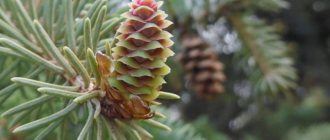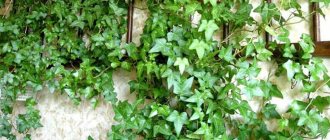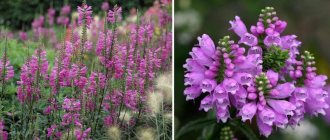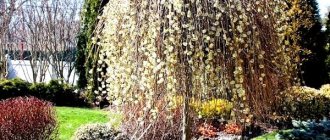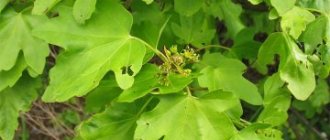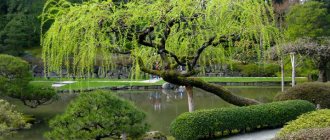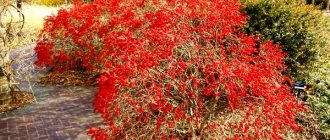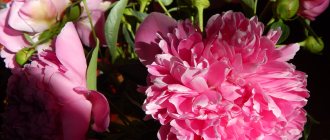Evergreen spruce is a spectacular representative of coniferous crops, adding a unique charm to garden design. The prickly beauty often becomes the accent of a landscape composition, creating a unique artistic effect, filling it with depth of color and volume.
There are more than 50 types of culture, distributed mainly in the Northern Hemisphere. In nature, coniferous trees grow in mountain forests and are occasionally found in flat areas.
Coniferous plants take root well on river banks, where they receive sufficient flowing moisture, avoiding heavily waterlogged soils.
In landscape design for relatively small areas, medium-sized (10-15 m tall) or dwarf forms (up to 2.5 m) are mainly used. In nature, traditional beauties can reach a height of 40-50 m and higher.
The culture is unpretentious, so even a novice gardener can care for blue spruce or other popular species.
Important Features
All types of spruce trees belong to shade-tolerant species, but only trees in open areas have a regular cone-shaped crown, descending almost to the ground, and rich green needles. This feature must be taken into account and incorrect, close planting of spruce trees must be avoided.
Despite its high frost resistance, spruce is sensitive to late spring frosts, which often damage young shoots of trees growing in open areas. That is why young spruce trees feel best under the canopy of other trees that protect the delicate needles.
Combination of tall and dwarf spruces
Inverse spruce with weeping needles is perfect for the original decor of a summer cottage. Due to its originality, it can be combined with almost any plant, and for contrast, you can plant some kind of dwarf spruce nearby. The advantage of Inverse spruce is that it can be given any desired height.
Spruce Inversa (Picea abies Inversa) is a variety of common spruce, which is called weeping because of the similarity of its shape to willow: its shoots hang strongly, and the lower branches of an adult tree lie on the ground. Inversa can grow up to 6-8 m, the diameter of an adult tree is from 2 to 2.5 m. It has thick shiny dark green needles.
The use of fir trees in landscape design
Preservation of decorative properties throughout the year, a large number of garden forms and varieties allow the use of spruce in landscape design in a very diverse manner. Traditional varieties with a slender pyramidal crown and tiered branches
planted singly as a dominant and as part of pure and mixed groups, used to create strict ceremonial alleys and protective scenes.
Thanks to its dense crown, which allows little light to pass through, spruce can be successfully used when decorating secluded recreation areas, as well as for decorating nondescript places in the garden.
Tall spruces
can form the basis of arrays and flower beds in large parks. They are perfect for solitary (in other words, single) planting on a uniform background, where the advantages of an impeccable crown and branches look most advantageous.
Dwarf Christmas trees
very effective in landscape compositions created on the principle of contrast of shape and color, in combination with other low-growing coniferous and deciduous species.
The miniature varieties of spruce trees bred by breeders are varied and elegant; they differ in size, crown structure (from conical and spherical to cushion-shaped, creeping, prostrate) and the color of the needles (various shades of green, bluish, silver, steel color). Groups of miniature conifers can decorate a small garden, rocky hills, even flower beds. Tip
Dwarf spruce trees are also grown in containers on terraces, roofs and balconies of houses. To avoid loss of compactness, dwarf varieties should not be grown on overly fertile soils.
The ability of spruce to be easily trimmed and retain its given shape is one of its many advantages and allows you to create attractive dense coniferous hedges and green walls. The geometrically correct, symmetrical shape of the crown, clear silhouette and dark green needles of spruce trees produce a strict, even solemn impression, which is why spruce trees are often used to decorate parterre areas, as well as in regular-style gardens.
Spruce goes well with other conifers, including varieties with silver, bluish, and golden shades of needles. Against the dark background of spruces, lighter groups of deciduous trees and shrubs, flower beds, and lawns look very expressive.
As for herbaceous plants, it should be remembered that the dense shade and acidic soil under the spruce canopy make it difficult to select companions. The vast majority of plants in dense shade have a depressed appearance, grow poorly, stretching upward, and flowering is weak and short-lived. Various ferns, astilbe, oxalis, and lily of the valley, which can be planted in relative proximity to spruce trees, tolerate such difficult conditions.
General rules for caring for conifers
When caring for conifers, you should remember that such plants are unpretentious and undemanding, but when growing them it is better to underfeed them with fertilizers than to overfeed them. Along with other gymnosperms, fir trees prefer alkaline soils with a pH of 4.5-6.0, therefore, in order to prevent acidification, you need to use special deoxidizers, and also carefully study the composition on the fertilizer package. The soil does not have to be rich in microelements, and the main care measures are as follows:
- without moistening the soil, the crop can easily grow for several weeks, but any highly decorative varieties must be provided with weekly irrigation measures at the rate of a bucket of water per square meter;
- when watering, it is necessary to prevent water from entering the above-ground part of the plant;
- in order to maintain sufficient moisture and prevent rotting of the root system, it is recommended to mulch the tree trunk with pine sawdust or bark;
- It is recommended to feed decorative varieties once a season with standard complex formulations and growth stimulants;
- crown formation must be carried out necessarily, which is beneficial for appearance and health;
- In spring and autumn, it is imperative to trim off all damaged, dried or diseased branches.
Almost all adult trees can easily tolerate winter frosts, but it is advisable to cover young plants and decorative conifers with the onset of severe cold, and also tie up branches to protect them from breaking off under the weight of the snow mass.
Common spruce, or European spruce (Picea abies, Picea excelsa),
has a large number of decorative forms and varieties, many of which are of greater interest for use in the garden than the original species.
Currently, countless dwarf varieties of Norway spruce are in demand, which are used in landscape design:
- ' Echiniformis ' with a cushion-shaped crown;
- '
Nidiformis ' and
'Little Gem
' – nest-shaped; - ' Procumbens ' – with a wide and flat crown;
- 'Pygmaea' – rounded.
Norway spruce 'Pygmaea'
Norway spruce 'Procumbens'
Norway spruce 'Nidiformis'
Planting spruce trees with contrasting needles
Due to the color of its crown, Hoopsey spruce will be an excellent contrast when paired with Norway spruce. This composition can be used to decorate any place in the garden, but spruce trees planted along the path to the house will look most advantageous.
Hoopsii Spruce (Picea pungens Hoopsii) is considered the most brightly colored of all known blue spruces: young needles are light blue in color, and the tree itself has a silvery tint. In 10 years it grows to approximately 5 m, in 30 years – up to 10 m. The diameter of an adult plant is 4 m.
'Hoopsii' and 'Koster'
Very valuable are the medium-sized varieties of prickly spruce ' Hoopsii' and 'Koster ' , growing up to 15 m, which can often be seen as New Year's trees on private plots.
Prickly spruce 'Hoopsii'
_______________________________________________________________
Spruce Glauca
Source: ld7.ru
This variety is the most popular, and its affordable price plays a significant role. This is what causes most errors. The faster a tree grows, the cheaper it costs! You buy a small one, and you get a spruce up to 15-20 meters in height, which reaches 6-8 meters in width. Conclusion : such a spruce is suitable only for a large area. Also, you should not place large trees near it.
Serbian or Balkan spruce (Picea omorika)
It is distinguished by a very narrow, pointed crown, which gives the tree lightness and grace. In gardens, it is most often planted singly or in small homogeneous groups and serves as the dominant vertical.
Serbian spruce
The dwarf forms of this spruce are very attractive in landscape design - ' Nana ' , whose height in adulthood does not exceed 3 m, and ' Gnom ' with a height of 1.5 m.
Serbian spruce 'Nana'
________________________________________________________________
Varieties of decorative spruce
The general description of the plant includes more than 50 species of coniferous trees. Let's consider the most common types used to design a garden or summer cottage:
- Common spruce . The first 10 years of growth are too slow; it grows only a few centimeters per year. The active growth phase lasts up to 100 years, after which growth slows down again. The bark of a young tree is slightly reddish, with virtually no cracks. The shoots are bare and yellow-brown in color. The buds are small with a pointed tip. The needles grow to a maximum of 20 mm, with a characteristic prickly tip, and change every 10-12 years of life. The cones are ovoid in shape. The seeds are small, although three times larger than the grain itself; the period of opening the cone and dispersing the grains begins at the end of January. Many inexperienced gardeners make the mistake of decorating their garden area with ordinary spruce; after 50 years it occupies a large area and brings discomfort to other garden plants.
- Spruce Echiniformis. Dwarf decorative spruce, growing up to 20 cm in height and up to 40 cm in width. It differs from the usual cushion-shaped (bush).
Spruce echiniformis
Looks like a lush bush with characteristic buds and cones for a coniferous plant. Reproduction occurs by seed dispersal or modernized grafting. - Decorative spruce Konika. A variety of ornamental resinous plant, descended from a mutation of a Canadian species.
Spruce Konika
Height does not exceed 2 meters. It differs from other trees in the growth of its branches from the ground, due to which the tree is always lush with characteristic light green needles. The needles are soft and pleasant to the touch. - Engelmann's garden spruce. It's a graceful look. The only thing that distinguishes such spruce trees from others is the direction of the branches - they are inclined downwards, giving the tree an unusual appearance.
Engelmann spruce
In winter, the color of the needles changes, they become less attractive, but still this variety occupies a leading place among ornamental plants.
Gray or Canadian spruce (Picea glauca)
The color of the needles is gray. The most popular are dwarf Canadian spruce trees, characterized by very slow growth, a compact and dense low-slung crown:
- everyone's favorite ' Conica
' (the most popular conical shape);
Canadian spruce 'Conica'
- ' Echiniformis
' is an extremely slow growing spruce up to 0.6 m high, with a rounded crown.
Canadian spruce 'Echiniformis'
_______________________________________________________________
Decorating areas near the house with fir trees
The combination of a variety of meadow flowers planted in groups around the spruce will make the landscape unique. Here you can also experiment: for example, plant dwarf spruce trees next to bright flowers. An equally winning option is blue spruce in combination with thujas, cypresses and bright red wild or garden flowers.
Blue spruce, or prickly spruce (Picea pungens) is an evergreen coniferous tree 25-30 m high. Its needles, 15-30 mm long, are painted in a variety of original shades, close in their range to blue. Initially, the tree lived exclusively in several states of the United States; later, its breeding varieties were bred in other countries, including Russia.
We recommend reading:
Healing properties of spruce
Eastern spruce cones
In the needles
contains essential oil, tannins, resins, vitamin C, phytoncides, carotene, aluminum, manganese, chromium and iron salts.
Winter tree problems
In this article, we give some advice to those who want to do without a designer, and also give reasons why you should not neglect the services of a specialist to create a durable, harmonious and safe garden on your site.
Reproduction
Planting Tompa spruce seedlings is best done in autumn or spring. Before preparing planting material, it is grown from seeds or obtained by cuttings. Both methods are suitable for propagating spruce.
Use of seeds:
- in the spring, collected in the fall, they are stratified under snow (1-4 months);
- before planting, soak for several hours in a solution with microelements that accelerate the development process;
- sowing is carried out in sun-warmed soil or in small containers with soil;
- The germination rate of greenhouse seedlings differs from that in open ground. The latter will sprout only after the frosts have ended, but they will be stronger and less susceptible to diseases;
- The seedlings need to be transplanted to a permanent place after one and a half to two years.
Propagation by cuttings:
- the age of the plant from which cuttings are taken must be at least five years, but not more than ten;
- It is better not to cut the twig, but to tear it off so that the “heel” remains on it, or use a sharp knife;
- a shoot 6-10 cm long should be no older than one year, but already with a formed area of bark;
- freshly cut cuttings are immediately planted in containers with prepared soil;
The best time for cuttings, as experienced gardeners say, is spring (late March - mid-May).
Growing conditions
As mentioned above, the Tompa spruce is quite unpretentious in cultivation, but in the first years of its life it requires attention. The first thing worth noting is that she is moisture-loving. The Christmas tree does not tolerate prolonged elevated temperatures and dry winds very well.
Did you know? After a spruce tree dies, a clone can grow from its root. Thanks to this property, there is spruce in Sweden, which is more than 9 thousand years old.
Under such unfavorable conditions, it must be watered a couple of times a week with 10–12 liters at the root and be sure to use sprinkling to irrigate the crown. In order to retain moisture, the tree trunk circle within the radius of the crown must be mulched with suitable materials - crumbs, peat, bark, organic matter or synthetic decorative mulch. Spruce can cope with short-term dry weather on its own.
The second thing to watch out for in the early stages of its development is recurrent spring or autumn frosts. Despite the fact that adult plants can easily tolerate frosts down to -40°C, to prevent young seedlings from freezing, they must be insulated with spruce branches or other covering materials.
Also find out if there is a difference between a fir tree and a fir tree.
The third feature in the cultivation of Tompa spruce is its non-perception of a polluted environment. For this reason, it is better to decorate country landscapes with it.
Subtleties of planting a seedling
The best time to plant spruce is spring or early autumn. To create the best starting conditions for the seedling, you can prepare a planting hole filled with a special soil mixture.
To do this, dig a hole approximately 60 centimeters deep. Drainage (15-20 centimeters thick) made of broken brick, sand or expanded clay is poured onto the bottom. The rest of the space is filled with a mixture of leaf, turf soil and peat in proportions 2:2:1. For better breathability, you can also add one part of river sand.
The seedling is placed so that the root collar is necessarily at ground level, after which the spruce is watered very generously and mulched with peat, sawdust, bark or other materials.
Spruce "Tompa" is very winter-hardy in the middle zone (winter hardiness zone 3) and does not require shelter for the winter. However, when planted in the fall, the tree will not have time to fully take root; the root system is not yet working at full strength, and this can also lead to spring burns. Therefore, in the first year after planting, it is better to cover the spruce with burlap.
